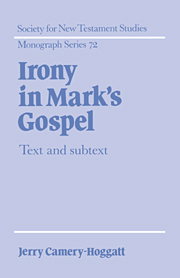Book contents
- Frontmatter
- Contents
- Preface
- List of abbreviations
- 1 Introduction: the problem of irony in Mark
- 2 The social functions of irony
- 3 The literary functions of narrative
- 4 Text and subtext: toward a rhetoric of irony
- 5 The Evidence of Irony in the Gospel of Mark
- 6 By way of summary
- Notes
- Bibliography
- Index
- CITATIONS FROM EXTRA-CANONICAL JEWISH LITERATURE
6 - By way of summary
Published online by Cambridge University Press: 22 October 2009
- Frontmatter
- Contents
- Preface
- List of abbreviations
- 1 Introduction: the problem of irony in Mark
- 2 The social functions of irony
- 3 The literary functions of narrative
- 4 Text and subtext: toward a rhetoric of irony
- 5 The Evidence of Irony in the Gospel of Mark
- 6 By way of summary
- Notes
- Bibliography
- Index
- CITATIONS FROM EXTRA-CANONICAL JEWISH LITERATURE
Summary
It may be a little odd to follow a treatment of the Gospel with an uninvited postscript. Odd, but not unprecedented. Very much more could be said if we were to extend our discussion to include narrative elements other than, and different from, irony. I suspect that in the light of those fuller discussions, our understanding of irony itself would take on a somewhat different aspect. Nevertheless, we can say some things.
First, it is important that the various effects of the narrative are tightly interwoven. The narrative is taken in as though it were an integrated whole. From this point of view, although the various thematic elements of Mark are distinct, and cannot be reduced to one another, they are also interrelated, and must be understood together. There are two reasons why this is so. First, polyvalence in narrative suggests that story elements may serve varieties of functions in the story-teller's overarching strategies. We discussed polyvalence in Chapters 2 and 3. There we pointed out that elements may be included which are clearly historical, but which serve the function of orienting the reader within the world of the story itself, or of directing the reader's attention to significances which the story-teller supposes are resident within the story's deeper structures. It is often the same with elements of genre, such as the silencing of the demons in the course of acts of exorcism.
- Type
- Chapter
- Information
- Irony in Mark's GospelText and Subtext, pp. 178 - 181Publisher: Cambridge University PressPrint publication year: 1992



